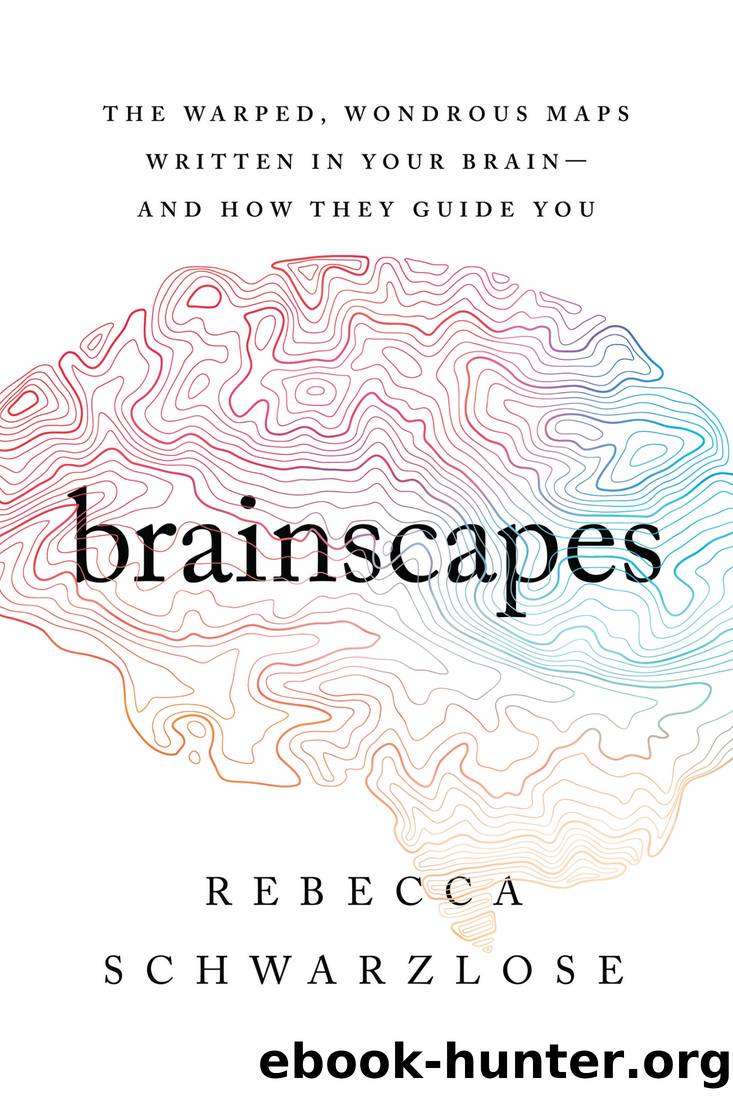Brainscapes by Rebecca Schwarzlose

Author:Rebecca Schwarzlose [Schwarzlose, Rebecca]
Language: eng
Format: epub
ISBN: 9781328949981
Published: 2021-06-15T00:00:00+00:00
FIGURE 31. An illustration of the major zones within the human object map.
Paul Kim
THE MAKING OF OBJECT MAPS
Where do the specialized zones in your object map come from? Given that the fetal brain contains visual and auditory maps even before seeing and hearing begin in earnest, could babies be born with zones for objects that they have not yet seen? This question has been hotly debated for quite some time. Finally, we now have tantalizing clues as to how zones within the object map do (and in some cases, do not) develop.
Turn back the clock to your time in the womb. The retinal waves that trained your early visual maps did not stop when they reached V1. But by the time these waves had journeyed from your retina through your thalamus and V1, out into the suburbs and then the exurbs of your V1 visual map, the strength and cohesion of these waves had lessened a great deal. The effect of these weak waves on the outlying territories of your immature visual cortex was to give them a slight preference for inputs from a particular region of the visual field. Some of these cells also had a slight preference for movement or basic visual features like shape or line curvature. But by and large, these cells were chemically and structurally immature, weeks behind those in your V1 visual map, your A1 sound-frequency map, and your other primary sensory maps in developing strong preferences and producing powerful signals. At the time of your birth, your nascent object map was something of a no-manâs-land of fledgling neurons awaiting guidance.
Once you entered the world, you had visual experiences upon which to train this no-manâs-land of cells. Newborns donât have that much control over what they look at; a small baby generally sees what adults put directly in front of its face. And for the most part, that is the adultâs own face. Babies younger than three months of age overwhelmingly see close frontal views of their caregivers. One study that recorded infantsâ visual environments logged fifteen minutes of close views of faces for every hour of footage. The position of human nipples might also factor into early face exposure, as it places newborns in close proximity to their motherâs face during prolonged periods of nursing. Such an up-close and intense early exposure to faces is the perfect way to teach that expanse of immature visual neurons, particularly those that already slightly prefer foveal inputs, to dedicate a hefty chunk of real estate to representing and processing faces. Crucially, this real estate will include the future home of the FFA face zone.
To better understand how specialized zones develop within the object map, a team of neuroscientists studied infant macaque monkeys. Adult macaques have an object map similar to that of adult humans; both include special zones involved in processing images of faces, body parts, objects, and scenes. The research team presented pictures to newborns macaques while scanning their nascent object maps with functional MRI. The scans revealed no trace of specialized zones for faces or objects.
Download
This site does not store any files on its server. We only index and link to content provided by other sites. Please contact the content providers to delete copyright contents if any and email us, we'll remove relevant links or contents immediately.
| Administration & Medicine Economics | Allied Health Professions |
| Basic Sciences | Dentistry |
| History | Medical Informatics |
| Medicine | Nursing |
| Pharmacology | Psychology |
| Research | Veterinary Medicine |
Periodization Training for Sports by Tudor Bompa(7929)
Why We Sleep: Unlocking the Power of Sleep and Dreams by Matthew Walker(6363)
Paper Towns by Green John(4805)
The Immortal Life of Henrietta Lacks by Rebecca Skloot(4263)
The Sports Rules Book by Human Kinetics(4079)
Dynamic Alignment Through Imagery by Eric Franklin(3925)
ACSM's Complete Guide to Fitness & Health by ACSM(3827)
Kaplan MCAT Organic Chemistry Review: Created for MCAT 2015 (Kaplan Test Prep) by Kaplan(3805)
Introduction to Kinesiology by Shirl J. Hoffman(3629)
Livewired by David Eagleman(3535)
The River of Consciousness by Oliver Sacks(3421)
The Death of the Heart by Elizabeth Bowen(3342)
Alchemy and Alchemists by C. J. S. Thompson(3298)
Descartes' Error by Antonio Damasio(3168)
Bad Pharma by Ben Goldacre(3102)
The Emperor of All Maladies: A Biography of Cancer by Siddhartha Mukherjee(2934)
The Gene: An Intimate History by Siddhartha Mukherjee(2929)
The Fate of Rome: Climate, Disease, and the End of an Empire (The Princeton History of the Ancient World) by Kyle Harper(2878)
Kaplan MCAT Behavioral Sciences Review: Created for MCAT 2015 (Kaplan Test Prep) by Kaplan(2823)
